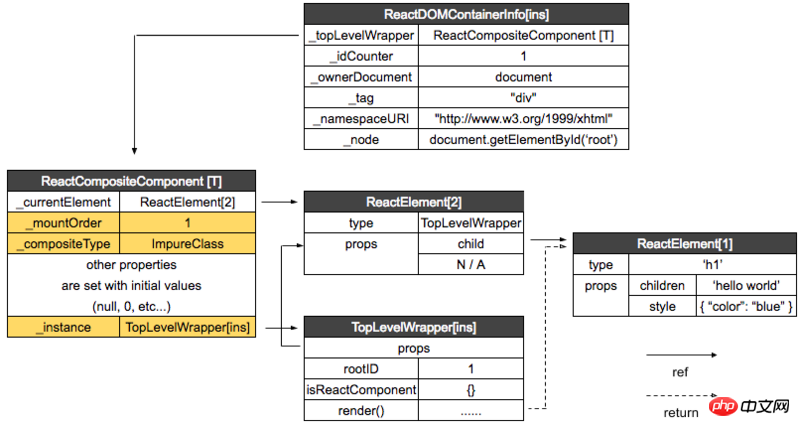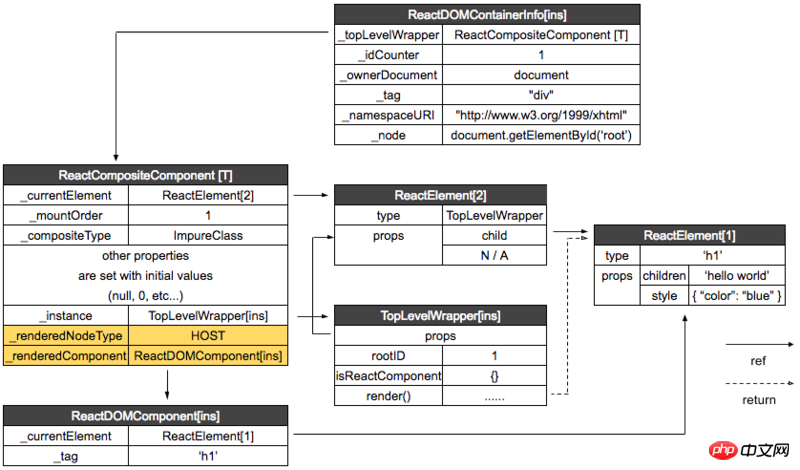React首次渲染解析二(純DOM元素)
這篇文章帶給大家的內容是關於React首次渲染解析二(純DOM元素),有一定的參考價值,有需要的朋友可以參考一下,希望對你有幫助。
上一篇文章中,介紹了頂層物件ReactCompositeComponent[T]是如何建構的,接下來我們來看看 batchedMountComponentIntoNode 做了什麼事情。
本文將要講解的呼叫堆疊是下面這個樣子的:
|=ReactMount.render(nextElement, container, callback) ___ |=ReactMount._renderSubtreeIntoContainer() | |-ReactMount._renderNewRootComponent() | |-instantiateReactComponent() | |~batchedMountComponentIntoNode() upper half |~mountComponentIntoNode() (平台无关) |-ReactReconciler.mountComponent() | |-ReactCompositeComponent.mountComponent() | |-ReactCompositeComponent.performInitialMount() | |-instantiateReactComponent() _|_ |-ReactDOMComponent.mountComponent() lower half |-_mountImageIntoNode() (HTML DOM 相关) _|_
如果看源碼,我們會留意到很多transaction相關的程式碼,我們暫時先將其忽略,會在後續的文章中進行講解。暫時可以理解為呼叫transaction.perform時,其實就是對第一個參數進行函數呼叫。跳過一些模版程式碼後,實際上做事情的是 mountComponentIntoNode 這個方法。
// 文件位置:src/renderers/dom/client/ReactMount.js
function mountComponentIntoNode(
wrapperInstance, // ReactCompositeComponent[T]
container, // document.getElementById("root")
transaction,
shouldReuseMarkup,
context
) {
...
var markup = ReactReconciler.mountComponent(
wrapperInstance,
transaction,
null,
ReactDOMContainerInfo(wrapperInstance, container),
context,
0 /* parentDebugID */
);
...
ReactMount._mountImageIntoNode(
markup,
container,
wrapperInstance,
shouldReuseMarkup,
transaction
);
}ReactReconciler.mountComponent 用於建立 DOM 元素,而 ReactMount._mountImageIntoNode 則是將剛建立的 DOM 元素掛載到頁面。 ReactReconciler.mountComponent 會呼叫 ReactCompositeComponent[T]的 mountComponent 方法。在看mountComponent 方法前,還需要先準備好hostContainerInfo,由ReactDOMContainerInfo 產生:
// 文件位置:src/renderers/shared/stack/reconciler/ReactContainerInfo.js
function ReactDOMContainerInfo(
topLevelWrapper, // ReactCompositeComponent[T]
node // document.getElementById("root")
) {
var info = {
_topLevelWrapper: topLevelWrapper,
_idCounter: 1,
_ownerDocument: node ?
node.nodeType === DOC_NODE_TYPE ? node : node.ownerDocument : null,
_node: node,
_tag: node ? node.nodeName.toLowerCase() : null,
_namespaceURI: node ? node.namespaceURI : null,
};
...
return info;
}現在各實例間的關係是這樣的:

#再繼續看mountComponent 方法:
// 文件位置:src/renderers/shared/stack/reconciler/ReactCompositeComponent.js
mountComponent: function (
transaction,
hostParent,
hostContainerInfo,
context
) {
...
// this._currentElement 为ReactElement[2](TopLevelWrapper)
var publicProps = this._currentElement.props;
var publicContext = this._processContext(context);
// TopLevelWrapper
var Component = this._currentElement.type;
...
// Initialize the public class
var doConstruct = shouldConstruct(Component);
// 生成TopLevelWrapper 实例
var inst = this._constructComponent(
doConstruct,
publicProps,
publicContext,
updateQueue
);
...
var markup;
...
markup = this.performInitialMount(renderedElement,
hostParent, hostContainerInfo, transaction, context
...
return markup;
},
performInitialMount: function (renderedElement, hostParent,
hostContainerInfo, transaction, context) {
// TopLevelWrapper 实例
var inst = this._instance;
...
// If not a stateless component, we now render
if (renderedElement === undefined) {
// 返回值为 ReactElement[1]
renderedElement = this._renderValidatedComponent();
}
// 返回 ReactNodeTypes.HOST
var nodeType = ReactNodeTypes.getType(renderedElement);
this._renderedNodeType = nodeType;
// instantiateReactComponent.js
var child = this._instantiateReactComponent(
renderedElement,
nodeType !== ReactNodeTypes.EMPTY /* shouldHaveDebugID */
);
this._renderedComponent = child;
var markup = ReactReconciler.mountComponent(
child,
transaction,
hostParent,
hostContainerInfo,
this._processChildContext(context),
debugID
);
...
return markup;
},當運行到var child = this._instantiateReactComponent時,就會呼叫上篇文章說到的instantiateReactComponent檔:
// 文件位置:src/renderers/shared/stack/reconciler/instantiateReactComponent.js
function instantiateReactComponent(node, shouldHaveDebugID) {
var instance;
...
} else if (typeof node === 'object') {
...
// element.type 为 ‘h1’
if (typeof element.type === 'string') {
instance = ReactHostComponent.createInternalComponent(element);
}
return instance;
}ReactDom 會在執行的時候,執行ReactDefaultInjection.inject()將ReactDOMComponent 注入到ReactHostComponent 中,ReactHostComponent.createInternalComponent 最終會呼叫ReactDOdeed #我們將傳回的實例命名為ReactDOMComponent[ins]。
ReactReconciler.mountComponent 會呼叫 ReactDomComponent 的 mountComponent 方法,這就會牽涉到 HTML DOM 相關的內容,我們在下一篇文章會講解。
現在我們來看各實例間的關係:
 #目前為止的呼叫堆疊:
#目前為止的呼叫堆疊:
// 文件位置:src/renderers/dom/shared/ReactDomComponent.js
function ReactDOMComponent(element) {
// h1
var tag = element.type;
validateDangerousTag(tag);
// ReactElement[1]
this._currentElement = element;
this._tag = tag.toLowerCase();
this._namespaceURI = null;
this._renderedChildren = null;
this._previousStyle = null;
this._previousStyleCopy = null;
this._hostNode = null;
this._hostParent = null;
this._rootNodeID = 0;
this._domID = 0;
this._hostContainerInfo = null;
this._wrapperState = null;
this._topLevelWrapper = null;
this._flags = 0;
}以上是React首次渲染解析二(純DOM元素)的詳細內容。更多資訊請關注PHP中文網其他相關文章!

熱AI工具

Undresser.AI Undress
人工智慧驅動的應用程序,用於創建逼真的裸體照片

AI Clothes Remover
用於從照片中去除衣服的線上人工智慧工具。

Undress AI Tool
免費脫衣圖片

Clothoff.io
AI脫衣器

AI Hentai Generator
免費產生 AI 無盡。

熱門文章

熱工具

記事本++7.3.1
好用且免費的程式碼編輯器

SublimeText3漢化版
中文版,非常好用

禪工作室 13.0.1
強大的PHP整合開發環境

Dreamweaver CS6
視覺化網頁開發工具

SublimeText3 Mac版
神級程式碼編輯軟體(SublimeText3)

熱門話題
 如何使用WebSocket和JavaScript實現線上語音辨識系統
Dec 17, 2023 pm 02:54 PM
如何使用WebSocket和JavaScript實現線上語音辨識系統
Dec 17, 2023 pm 02:54 PM
如何使用WebSocket和JavaScript實現線上語音辨識系統引言:隨著科技的不斷發展,語音辨識技術已成為了人工智慧領域的重要組成部分。而基於WebSocket和JavaScript實現的線上語音辨識系統,具備了低延遲、即時性和跨平台的特點,成為了廣泛應用的解決方案。本文將介紹如何使用WebSocket和JavaScript來實現線上語音辨識系
 WebSocket與JavaScript:實現即時監控系統的關鍵技術
Dec 17, 2023 pm 05:30 PM
WebSocket與JavaScript:實現即時監控系統的關鍵技術
Dec 17, 2023 pm 05:30 PM
WebSocket與JavaScript:實現即時監控系統的關鍵技術引言:隨著互聯網技術的快速發展,即時監控系統在各個領域中得到了廣泛的應用。而實現即時監控的關鍵技術之一就是WebSocket與JavaScript的結合使用。本文將介紹WebSocket與JavaScript在即時監控系統中的應用,並給出程式碼範例,詳細解釋其實作原理。一、WebSocket技
 如何利用JavaScript和WebSocket實現即時線上點餐系統
Dec 17, 2023 pm 12:09 PM
如何利用JavaScript和WebSocket實現即時線上點餐系統
Dec 17, 2023 pm 12:09 PM
如何利用JavaScript和WebSocket實現即時線上點餐系統介紹:隨著網路的普及和技術的進步,越來越多的餐廳開始提供線上點餐服務。為了實現即時線上點餐系統,我們可以利用JavaScript和WebSocket技術。 WebSocket是一種基於TCP協定的全雙工通訊協議,可實現客戶端與伺服器的即時雙向通訊。在即時線上點餐系統中,當使用者選擇菜餚並下訂單
 如何使用WebSocket和JavaScript實現線上預約系統
Dec 17, 2023 am 09:39 AM
如何使用WebSocket和JavaScript實現線上預約系統
Dec 17, 2023 am 09:39 AM
如何使用WebSocket和JavaScript實現線上預約系統在當今數位化的時代,越來越多的業務和服務都需要提供線上預約功能。而實現一個高效、即時的線上預約系統是至關重要的。本文將介紹如何使用WebSocket和JavaScript來實作一個線上預約系統,並提供具體的程式碼範例。一、什麼是WebSocketWebSocket是一種在單一TCP連線上進行全雙工
 JavaScript與WebSocket:打造高效率的即時天氣預報系統
Dec 17, 2023 pm 05:13 PM
JavaScript與WebSocket:打造高效率的即時天氣預報系統
Dec 17, 2023 pm 05:13 PM
JavaScript和WebSocket:打造高效的即時天氣預報系統引言:如今,天氣預報的準確性對於日常生活以及決策制定具有重要意義。隨著技術的發展,我們可以透過即時獲取天氣數據來提供更準確可靠的天氣預報。在本文中,我們將學習如何使用JavaScript和WebSocket技術,來建立一個高效的即時天氣預報系統。本文將透過具體的程式碼範例來展示實現的過程。 We
 簡易JavaScript教學:取得HTTP狀態碼的方法
Jan 05, 2024 pm 06:08 PM
簡易JavaScript教學:取得HTTP狀態碼的方法
Jan 05, 2024 pm 06:08 PM
JavaScript教學:如何取得HTTP狀態碼,需要具體程式碼範例前言:在Web開發中,經常會涉及到與伺服器進行資料互動的場景。在與伺服器進行通訊時,我們經常需要取得傳回的HTTP狀態碼來判斷操作是否成功,並根據不同的狀態碼來進行對應的處理。本篇文章將教你如何使用JavaScript來取得HTTP狀態碼,並提供一些實用的程式碼範例。使用XMLHttpRequest
 javascript如何使用insertBefore
Nov 24, 2023 am 11:56 AM
javascript如何使用insertBefore
Nov 24, 2023 am 11:56 AM
用法:在JavaScript中,insertBefore()方法用於在DOM樹中插入一個新的節點。這個方法需要兩個參數:要插入的新節點和參考節點(即新節點將要插入的位置的節點)。
 JavaScript與WebSocket:打造高效率的即時影像處理系統
Dec 17, 2023 am 08:41 AM
JavaScript與WebSocket:打造高效率的即時影像處理系統
Dec 17, 2023 am 08:41 AM
JavaScript是一種廣泛應用於Web開發的程式語言,而WebSocket則是一種用於即時通訊的網路協定。結合二者的強大功能,我們可以打造一個高效率的即時影像處理系統。本文將介紹如何利用JavaScript和WebSocket來實作這個系統,並提供具體的程式碼範例。首先,我們需要明確指出即時影像處理系統的需求和目標。假設我們有一個攝影機設備,可以擷取即時的影像數






